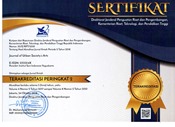INDONESIAN DOCUMENTARY: A THEORETICAL REVIEW OF TRUTH CLAIMS PERSPECTIVE
Abstract
Keywords
Full Text:
PDFReferences
Aaltonen, J. and Kortti, J., 2015, From evidence to re-enactment: history, television and documentary film, Journal of Media Practice. Vol. 16, No. 2, pp. 108–125,
Aguilar, G, 2013, The Documentary: Between Reality and Fiction, Between First and Third Person dalam New Argentine and Brazilian Cinema, Diedit oleh Andermann, J. London: Jens Andermann and Álvaro Fernández Bravo, p. 203.
Antonacopoulou, E.P. and Gabriel, Y., 2001, Emotion, learning and organizational change: Towards an integration of psychoanalytic and other perspective. Journal of Organizational Change Management; 14, 5; ProQuest, p. 435
Alasuutari, P., 1995, Researching Culture: Qualitative Method and Cultural Studies, London: Sage Publications.
________________, ed, 1999, Rethinking The Media Audience: The New Agenda, London: Sage Publications.
Arnheim, R., 1957, Film As Art. Los Angeles: University of California Press.
Arps, B. Heeren K. V. and Nordholt, H. S. (ed), 2006, Ghosthunting And Vulgar News: Popular Realities on Recent Indonesian Television, Yogyakarta: Pustaka Pelajar.
Aufderheide, P., 2007, Documentary Film a Very Short Introduction, New York: Oxford University Press.
Barendregt, B., 2006, A Supernatural Topography of The Southern Sumatran Highlands, Crossroads: An Interdisciplinary Journal of Southeast Asian Studies, Vol. 18, No. 1(2006), pp. 113-125.
Beattie, K., 2004, Documentary Screen Non-Fiction Film and Television, New York: Palgrave.
Becker, H.S., 198,. Art World (25th anniversary edition), Berkeley: University of California Press.
Bergman, T., 2004, Personal narrative, dialogism, and the performance of “truth” in complaints of a dutiful daughter. Journal of Text and Performance Quarterly Vol. 24, No. 1, January, pp. 3-20.
Bernard, S.C., 2007, Documentary Storytelling, Oxford: Elsevier.
Blumenberg, R.M., 1977, Documentary Films and the Problem of "Truth". Journal of the University Film Association, Vol. 29, No. 4, pp. 19-22.
Bondebjerg, I., 2014, Documentary and Cognitive Theory: Narrative, Emotion and Memory. Journal of Media and Communication, Volume 2, Issue 1, pp. 13–22.
Bordwell, D., 1985, Narration In The Fiction Film, Wisconsin: The University of Wisconsin Press.
_____________ and R. Burton Palmer (ed), 1989, Historical Poetic of Cinema (The Cinematic Text: Methods and Approaches. Georgia State Literary Studies No. 3, p. 369.
_____________ and Carroll, N., 1996, Post-Theory: Reconstructing Film Studies, Wisconsin: The University of Wisconsin Press.
_____________, 1991, Making Meaning: Iinference And Rhetoric In The Interpretation of Cinema, Cambridge: Harvard University Press.
Bruzzi, S., 2006, New Documentary (2nd edition), New York: Routledge.
Buckland, W., 2004, The Cognitive Semiotics of Film, Cambridge: Cambridge University Press.
Carroll, N., 1997, The Essence of Cinema. Philosophical Studies: An International Journal for Philosophy in the AnalyticTradition, Vol. 89, No. 2/3, The American Philosophical Association Pacific Division Meeting (Mar., 1998), pp. 323-330
__________, 1996, Theorizing The Moving Image, Cambridge: Cambridge University Press.
__________, 2003, Engaging The Moving Image, New Haven&London: Yale University Press.
Cavallaro, D., 2004, Critical and Cultural Theory, Yogyakarta: Niagara.
Chatman, S.B., 1978, Story and Discourse: Narrative Structure in Fiction and Film, New York: Cornell University Press.
Collins, D., 2003, Pretesting Survey Instruments: An Overview of Cognitive Methods, Quality of Life Research 12, Hal. 229–238.
De Caro, M. and E. Terrone, 2016, The View From Outside: On A Distinctively Cinematic Achievement, Philosophy and Social Criticism, 2016, Vol. 42(2), pp. 154–170.
Eisenstein, S., 1969, Film Form, San Diego: A Harvest Book.
Ellis, J.C., 1989, The Documentary Idea: A Critical History of English-Language Documentary Film and Video, New Jersey: Prentice Hall.
Fiske, J., 1987, Television Culture: Popular Pleasures and Politics. London: Routledge.
Knafl, K. and L. M. Given, (ed), 2008, The Sage Encyclopedia of Qualitative Research Methods, Los Angeles: SAGE Publications, Inc.
Heider, K.G., 2006, Ethnographic Film, Austin: University of Texas Press.
Henley, D. and J. S., Davidson, 2008, In the Name of Adat: Regional Perspectives on Reform, Tradition, and Democracy in Indonesia, Cambridge University Press: Modern Asian Studies 42, 4 (2008) pp. 815–852
Hilderbrand, L., 2009, Introduction Experiment In Documentary: Contradiction, Uncertainty, Change. Millenium Film Journal; Spring; 51; ProQuest Research Library; p. 2.
Lehar, S., 2003, The World in Your Head: A Gestalt View of the Mechanism of Conscious Experience, London: Lawrence Elbaum Associates Publisher.
McCalman, I. dan Pickering, P. A., (ed), 2010, Historical Reenactment From Realism to the Affective Turn, London: Palgrave Macmillan.
McLane, B.A, 2012, A New History of Documentary Film, New York: Continuum.
Metz, C., 1991, Film Language: A Semiotics of The Cinema, Chicago: The Univ. Of Chicago Press.
_______________, 1983, Psychoanalysis and Cinema, London: Macmillan Press.
Michelle, C., 2007, Modes of Reception: A Consolidated Analytical Framework. The Communication Review, 10, pp. 181–222.
Moleong, L.J., 2013, Metodologi Penelitian Kualitatif, Bandung: Rosda.
Morley, D., 1986, Family Television: Cultural Power and Domestic Leisure, London: Comedia Publishing Group.
Musser, C., 2007, War, Documentary and Iraq Dossier: Film Truth in the Age of George W. Bush. Framework: The Journal of Cinema and Media, Vol. 48, No. 2 (Fall), pp. 9-35.
Nannicelli, T. and Taberham, P., 2014. Cognitive Media Theory, New York: Routledge.
Nash, K, 2010, Exploring Power And Trust In Documentary: A Study of Tom Zubrycki's Molly and Mobarak. SDF 4 (1) pp. 21–33. Intellect Limited.
Nichols, B., 2001, Introduction to Documentary, Bloomington: Indiana University Press.
___________, 2008, Documentary Reenactment and the Fantasmatic Subject. Critical Inquiry, Vol. 35, No. 1 (Autumn), pp. 72-89
Nordholt, H. S., 2007, The State On The Skin: Clothes, Shoes, and Neatness In (colonial) Indonesia, Asian Studies Review, 21:1, 19-39, DOI: 10.1080/03147539708713139
Norman, K. D. and Lincoln, I. S. (ed.), 1994, Handbook of Qualitative Research, London: Sage Publications.
Otway, F., 2015, The Unreliable Narrator in Documentary. Journal of Film and Video 67, pp. 3–4
Plantinga, C.R., 1997, Rhetoric and Representation in Nonfiction Film, Cambridge: Cambridge University Press.
_______________, 2006, Cognitive Theory in Film Studies. College Literature, Vol. 33, No. 1, Cognitive Shakespeare: Criticism and Theory in the Age of Neuroscience (Winter), pp. 215-224.
_______________, 2009, Moving Viewers: American Film and The Spectator’s Experience, Berkeley: University of California Press.
Peransi, D.A, 2005, Film/Media/Seni, Jakarta: FFTV IKJ.
Persson, P., 2003, Understanding Cinema: A Psychological Theory of Moving Imagery, Cambridge: Cambridge University Press.
Rae, P., 2016, The Powers of Transmedia Performance, Yogyakarta: PSPSR (The Power of Art Conference, Held in Sekolah Pascasarjana Universitas Gadjah Mada Yogyakarta Indonesia, October 28th 2016).
Renov, M., 1993, Theorizing Documentary, London: Routledge.
Rosenthal, A. (ed), 1988, New Challenge for Documentary: The Voice of Documentary, Berkeley: University of California.
Rotha, P. and Breitrose, H. (ed)., 1974, Documentary Diary. Film Quarterly, Vol. 27, No. 3 (Spring), pp. 52-54
Ruby, J., 1992. Speaking For, Speaking About, Speaking With, or Speaking Alongside: An Anthropologycal and Documentary Dilemma, Journal of Film and Video, Vol. 44, No. 1/2, International Issues (Spring andSummer), pp. 42-66.
Sanders, W., 2012, The Aggie Will Come First Indeed. A Survey on Documentary Filmmakers Dealing With Participants. New Review of Film and Television Studies. Vol. 10, No. 3, September, pp. 387–408.
Sen, K. and Hill, D. T., 2007, Media, Culture, and Politics in Indonesia, Jakarta: Equinox.
Setiawan, I., 2013, Membuka Layar Impian: Budaya Poskolonial Dalam Film Indonesia Era 2000-an, Disertasi: Universitas Gadjah Mada.
Spyer, P., 1996, Diversity with a Difference: Adat and the New Order in Aru (Eastern Indonesia), Cultural Anthropology, Vol. 11, No. 1 (Feb., 1996), pp. 25-50
Stam, R., et al., 2005, New Vocabularies In Film Semiotics, London: Routlegde.
Stoney, G.C., 1978, Must A Filmmaker Always Leave His Mark?. Makalah dipresentasikan pada “International Conference of Anthropologists and Filmmakers Meeting in Canberra, Australia, in May.
Sussex, E., 1972, Grierson on Documentary: The Last Interview. Film Quarterly (Archive); Fall; 26, 1; Arts & Humanities Full Text. p. 24.
Winston, B., 1999, Documentary: How the Myth Was Deconstructed, Wide Angle, Volume 21, Number 2, March, pp. 71-86.
Willis, G., Royston, P., & Bercini, D. 1991. The Use of Verbal Report Methods In The Development And Testing of Survey Questionnaires. Applied Cognitive Psychology, 5, pp. 251–267.
Zoebazary, I, 2010, Kamus Istilah Televisi dan Film, Jakarta: Gramedia.
Website
Axemaker, S., 2015, Early Silent Documentaries Real Life Adventure Cinema (internet), Independent Lens, (Accessed: 16 Juni 2016).
Enticknap, L., 2016, Grierson, John (1898-1972) (internet), Screen Online, (Accessed: 16 Juni 2016).
DOI: https://doi.org/10.24821/jousa.v7i1.3903
Refbacks
- There are currently no refbacks.

This work is licensed under a Creative Commons Attribution 4.0 International License. ISSN 2355-2131 (print) | ISSN 2355-214X (online).






